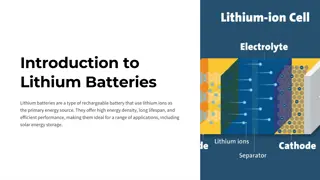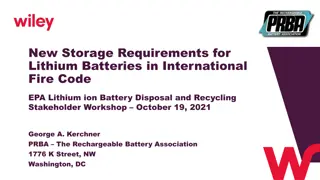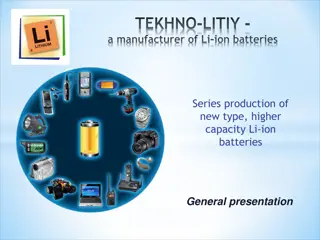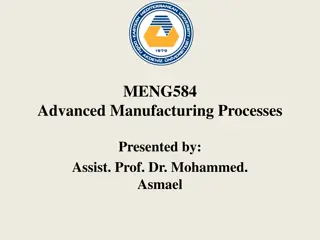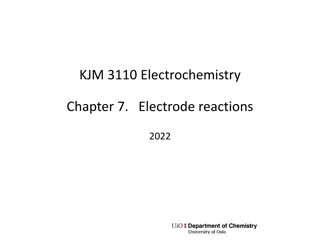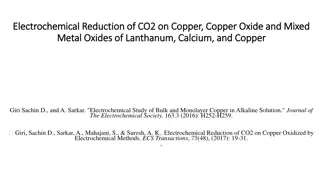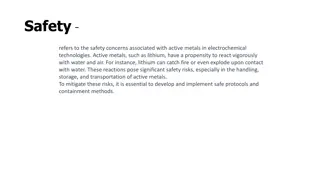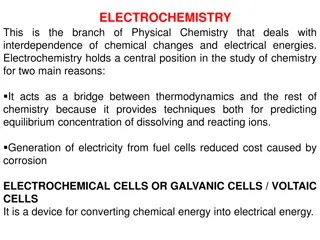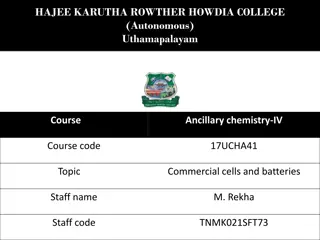Characteristics of Batteries and Electrochemical Principles
Batteries play a crucial role in converting chemical energy into electrical energy through reversible electrochemical reactions. Understanding the principles of anodes, cathodes, and redox couples like Cu2+/Cu and Zn2+/Zn is essential. The Daniell cell involving these redox couples can be drawn to specify electrode polarities. Additionally, factors determining battery performance, such as energy storage ratio, number of cycles, self-discharge rate, and ecological impact, are vital considerations. Various electrochemical characterization techniques like cyclic voltammetry and chronopotentiometry provide insights into oxidation/reduction potentials and charge/discharge profiles. By exploring these characteristics and principles, one can evaluate battery efficiency and functionality effectively.
Download Presentation

Please find below an Image/Link to download the presentation.
The content on the website is provided AS IS for your information and personal use only. It may not be sold, licensed, or shared on other websites without obtaining consent from the author.If you encounter any issues during the download, it is possible that the publisher has removed the file from their server.
You are allowed to download the files provided on this website for personal or commercial use, subject to the condition that they are used lawfully. All files are the property of their respective owners.
The content on the website is provided AS IS for your information and personal use only. It may not be sold, licensed, or shared on other websites without obtaining consent from the author.
E N D
Presentation Transcript
Characteristics of the batteries Fyodor Malchik
General principle Anode (-) M1(s) M1n+(aq)+ ne- Cathode (+) M2n+(aq)+ ne- M2(s) When E2>E1 M1(s) + M2n+(aq) M1n+(aq) + M2(s) Electromotive force = E2-E1
Exercice We consider the Daniell cell involving the redox couples: Cu2+/Cu (E = 0.34 V/SHE) and Zn2+/Zn (E = - 0.76 V/SHE) Zn ZnSO4 CuSO4 Cu 1. electrochemical 2. Draw the Daniell cell and specify the polarity of the respective electrodes (justify) 3. Calculate the equilibrium constant of this electrochemical cell 4. Calculate the e.m.f. when CuSO4 = 10-2M and ZnSO4 = 10-1M Establish the half equations and the resulting reaction
Principle Convert chemical energy into electrical energy Based on the reversible electrochemical reaction A (low energy) = B (high energy) Charge : A leads to B (non spontaneous) Discharge : B leads to A (spontanenous) Batteries are classified into primary and secondary forms. Primary batteries irreversibly transform chemical energy to electrical energy. When the supply of reactants is exhausted, energy cannot be readily restored to the battery Secondary batteries can be recharged; that is, they can have their chemical reactions reversed by supplying electrical energy to the cell, approximately restoring their original composition.
To determine the performance of a batterie The ratio between the energy stored and weight The ratio between the energy stored and volume The number of cycles The self-discharge The security issue The ecological impact The cost
Electrochemical Electrochemical characterization characterization Cyclic voltammetry (j vs V) To determine the oxidation/reduction potentials Chronopotentiometry (V vs t at j=constant) To establish the charge/discharge profiles (V vs the capacity) Electrochemical Impedance Spectroscopy Electron transfer, ionic conductivity, modelling of interfaces
General principle/ Daniell cell Zn(s) Zn2+(aq)+ 2e- Cu2+(aq)+ 2e- Cu(s) Zn(s) + Cu2+(aq) Zn2+(aq) + Cu(s) Open-circuit voltage 1.1 V
Characteristics Characteristicsof batteries of batteries The potential: U (V). In general 1 to few V It can be increased by assembling cells in series The current: i (A) or j(A/surface area). It can be increased by assembling cells in parralel The capacity (mAh or C) Gravimetric capacity (mAh/g) Volumetric capacity (mAh/cm3) Areal capacity (mAh/cm2) for microbatteries The energy density (mWh or J) E= Capacity X Average operating potential The power density (mW) E= Capacity X Average operating potential/Discharge time The internal impedance ( )
Li-ion batteries Principle and Applications
? Supercapacitors: High power density and low energy density Li-ion batteries: Low power density and high energy density
HYBRID 100% ELECTRIC
14 The Li The Li metal metaltechnology technology 1. Anode Anode: Li metal 2. Cathode Cathode : Host materials with high potential (Oxyde) Poor electronic conductivity. Mixed with C black and binders 3. Electrolyte Electrolyte: liquid (LiPF6+ EC/DEC) or polymer (PEO) 4. Current Currentcollectors collectors (Cu or Al) ECM/CM-> ELi+/Li Spontaneous reaction is the discharge Oxidation: Li = Li++ e- Reduction: Host + e-= Host- The overall reaction: Host + Li = Li+,Host-
Li batteries vs. Li Li batteries vs. Li- -ion batteries ion batteries Li Li- -metal battery (very high energy density) metal battery (very high energy density) - Safety problems (short circuit due to the dendrite formation during charging) The The lithium lithium- -ion safer. ion battery battery has a slightly lower energy density than lithium metal, but is much
Concept developed by SONY in 1990 using graphite (anode) and LiCoO2 ( cathode) Oxidation: LixC6= x Li++ xe-+ C6 Reduction: Li1-xMO2+xe-+ x Li+= LiMO2 Li1-xMO2 + LixC6= C6 + LiMO2
The The electrode electrodereaction reactionmechanisms mechanisms The main concern: the volume variation during cycling Insertion of Li = volume expansion extraction of Li = volume contraction Consequence : mechanical strain at the interface electrode/current collector leading to the lost of electrical contact
Example of Si: poor electrochemical performance (number of cycles<3) due to a volume expansion of 400% The The problem problemof volume variations of volume variations









